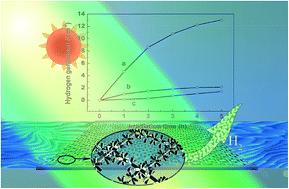An efficient photocatalyst used in a continuous flow system for hydrogen evolution from water: TiO2 nanotube arrays fabricated on Ti meshes†
Abstract
In the present work, TiO2 nanotube arrays were fabricated on metallic Ti meshes using anodic oxidation method, and decorated with Pt via electrodeposition. Meanwhile, the application of the TiO2 nanotube arrays loaded with Pt in a continuous flow system was explored as a photocatalyst for H2 evolution from water. Furthermore, for practical purposes, the photocatalytic H2 evolution was studied as a function of content of loaded Pt, annealing temperature, anodic oxidation time, and flow velocity. The results indicate that the TiO2 nanotube arrays fabricated on metallic Ti meshes are an efficient photocatalyst which can be used in a continuous flow system for H2 evolution from water. During the first hour of irradiation, a rate of H2 evolution of approximately 4.6 L m−2 h−1 was achieved under optimal conditions. Moreover, the photocatalytic activity of the TiO2 nanotube arrays fabricated on Ti meshes is obviously higher than that of the TiO2 nanotube arrays fabricated on metallic Ti foils. The rate of H2 evolution can increase by a factor of 5 when the TiO2 nanotube arrays are fabricated on metallic Ti meshes. Finally, the photocatalytic mechanism was preliminarily discussed.


 Please wait while we load your content...
Please wait while we load your content...